Golang is a blockbuster server side language in the field of efficiency and concurrency. If you are a Nodejs developer definitely you will come across express js for building your web api services. Gofiber is exactly like the express framework for golang and no doubt it booms with the efficiency of Fasthttp and golang.
In this blog post we will create a simple image upload server using gofiber and we will use reactjs for frontend to select image from file and upload to server.
we will use axios for http request to server and it is really awesome when we deal with implementing authentication and handling lots of api requests. It has lots of features which make life easy when dealing with api in react.
we will use chakra ui for designing material like button , images and layout it shins in Accessibility that directly effect better SEO.
library and tools we will use
- golang
- gofiber
- reactjs
- axios
- chakra ui
Setup backend
create new directory and enter into it
mkdir go-react-image-upload
cd go-react-image-upload
create a new directory server inside go-react-image-upload and enter into it
mkdir server
cd server
Setup go environment
go mod init github.com/harshmangalam
install packages required for backend
go get github.com/gofiber/fiber/v2
go get github.com/google/uuid
uuid will help to generate unique id so that we can name our image easily and no two image will have same name.
create new go file main.go inside server and start writting code
package main
import (
"fmt"
"log"
"os"
"strings"
"github.com/gofiber/fiber/v2"
"github.com/gofiber/fiber/v2/middleware/cors"
"github.com/google/uuid"
)
func main() {
// create new fiber instance and use across whole app
app := fiber.New()
// middleware to allow all clients to communicate using http and allow cors
app.Use(cors.New())
// serve images from images directory prefixed with /images
// i.e http://localhost:4000/images/someimage.webp
app.Static("/images", "./images")
// handle image uploading using post request
app.Post("/", handleFileupload)
// delete uploaded image by providing unique image name
app.Delete("/:imageName", handleDeleteImage)
// start dev server on port 4000
log.Fatal(app.Listen(":4000"))
}
func handleFileupload(c *fiber.Ctx) error {
// parse incomming image file
file, err := c.FormFile("image")
if err != nil {
log.Println("image upload error --> ", err)
return c.JSON(fiber.Map{"status": 500, "message": "Server error", "data": nil})
}
// generate new uuid for image name
uniqueId := uuid.New()
// remove "- from imageName"
filename := strings.Replace(uniqueId.String(), "-", "", -1)
// extract image extension from original file filename
fileExt := strings.Split(file.Filename, ".")[1]
// generate image from filename and extension
image := fmt.Sprintf("%s.%s", filename, fileExt)
// save image to ./images dir
err = c.SaveFile(file, fmt.Sprintf("./images/%s", image))
if err != nil {
log.Println("image save error --> ", err)
return c.JSON(fiber.Map{"status": 500, "message": "Server error", "data": nil})
}
// generate image url to serve to client using CDN
imageUrl := fmt.Sprintf("http://localhost:4000/images/%s", image)
// create meta data and send to client
data := map[string]interface{}{
"imageName": image,
"imageUrl": imageUrl,
"header": file.Header,
"size": file.Size,
}
return c.JSON(fiber.Map{"status": 201, "message": "Image uploaded successfully", "data": data})
}
func handleDeleteImage(c *fiber.Ctx) error {
// extract image name from params
imageName := c.Params("imageName")
// delete image from ./images
err := os.Remove(fmt.Sprintf("./images/%s", imageName))
if err != nil {
log.Println(err)
return c.JSON(fiber.Map{"status": 500, "message": "Server Error", "data": nil})
}
return c.JSON(fiber.Map{"status": 201, "message": "Image deleted successfully", "data": nil})
}
run main.go from server
go run main.go
Now our server is up and running we can test it using Postman
setup frontend
come outside from server directory and generate reactjs project using create-react-app
npx create-react-app reactjs
cd reactjs
install dependencies
npm i @chakra-ui/react @emotion/react@^11 @emotion/styled@^11 framer-motion@^4 axios
index.js
import React from 'react';
import ReactDOM from 'react-dom';
import App from './App';
ReactDOM.render(
<App />
,
document.getElementById('root')
);
setup App.js
import { Box, ChakraProvider, Container } from "@chakra-ui/react";
import Axios from "axios";
import Upload from "./components/Upload";
Axios.defaults.baseURL = "http://localhost:4000";
function App() {
return (
<ChakraProvider>
<Box
minH="100vh"
w="100%"
bg="gray.200"
display="flex"
alignItems="center"
justifyContent="center"
>
<Container maxWidth="container.xl">
<Upload />
</Container>
</Box>
</ChakraProvider>
);
}
export default App;
create new hook useUpload hook in hooks folder
hooks/useUpload.js
import { useState } from "react";
import axios from "axios";
import { useToast } from "@chakra-ui/react";
const useUpload = () => {
const [image, setImage] = useState(null);
const [loading, setLoading] = useState(false);
const [uploadedImage, setUploadedImage] = useState(null);
const toast = useToast();
const handleChangeImage = (e) => {
setImage(e.target.files[0]);
};
const handleUploadImage = async () => {
try {
setLoading(true);
const formData = new FormData();
formData.append("image", image);
const res = await axios.post("/", formData);
if (res.data.data) {
console.log(res.data);
setUploadedImage(res.data.data);
toast({
title: "Image Uploaded",
description: res.data.message,
status: "success",
duration: 4000,
isClosable: true,
});
}
} catch (error) {
console.log(error);
} finally {
setImage(null);
setLoading(false);
}
};
const handleRemoveImage = async () => {
try {
setLoading(true);
const res = await axios.delete(`/${uploadedImage.imageName}`);
if (res.data) {
console.log(res.data);
setUploadedImage(null);
toast({
title: "Image Deleted",
description: res.data.message,
status: "success",
duration: 4000,
isClosable: true,
});
}
} catch (error) {
console.log(error);
} finally {
setLoading(false);
}
};
return {
image,
uploadedImage,
loading,
handleChangeImage,
handleUploadImage,
handleRemoveImage,
};
};
export default useUpload;
create Upload.js inside components folder
components/Upload.js
import { Button, Heading, VStack, Image, HStack, Tag } from "@chakra-ui/react";
import React from "react";
import { useRef } from "react";
import useUpload from "../hooks/useUpload";
function Upload() {
const imageRef = useRef(null);
const {
loading,
image,
handleRemoveImage,
handleChangeImage,
handleUploadImage,
uploadedImage,
} = useUpload();
return (
<>
<input
style={{ display: "none" }}
type="file"
accept="image/*"
ref={imageRef}
onChange={handleChangeImage}
/>
<VStack>
<Heading>Image uploading using Golang and Reactjs</Heading>
<Button
onClick={() => imageRef.current.click()}
colorScheme="blue"
size="lg"
>
Select Image
</Button>
</VStack>
{image && (
<VStack my="4">
<Image
src={URL.createObjectURL(image)}
width="300px"
height="300px"
alt="selected image..."
/>
<Button
onClick={handleUploadImage}
variant="outline"
colorScheme="green"
isLoading={loading}
>
Upload
</Button>
</VStack>
)}
{uploadedImage && (
<VStack my="4">
<Image
src={uploadedImage.imageUrl}
width="300px"
height="300px"
alt={uploadedImage.imageName}
/>
<HStack>
<Tag variant="outline" colorScheme="blackAlpha">
~ {Math.floor(uploadedImage.size / 1024)} Kb
</Tag>
<Button
variant="solid"
colorScheme="red"
onClick={handleRemoveImage}
isLoading={loading}
>
Delete
</Button>
</HStack>
</VStack>
)}
</>
);
}
export default Upload;
Github Repo
Backend
Frontend
Getting Started with Create React App
This project was bootstrapped with Create React App.
Available Scripts
In the project directory, you can run:
npm start
Runs the app in the development mode.
Open http://localhost:3000 to view it in the browser.
The page will reload if you make edits.
You will also see any lint errors in the console.
npm test
Launches the test runner in the interactive watch mode.
See the section about running tests for more information.
npm run build
Builds the app for production to the build folder.
It correctly bundles React in production mode and optimizes the build for the best performance.
The build is minified and the filenames include the hashes.
Your app is ready to be deployed!
See the section about deployment for more information.
npm run eject
Note: this is a one-way operation. Once you eject, you can’t go back!
If you…


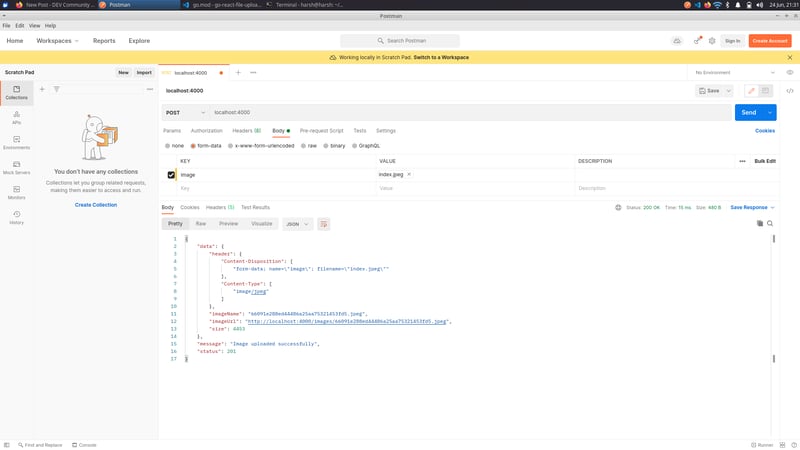
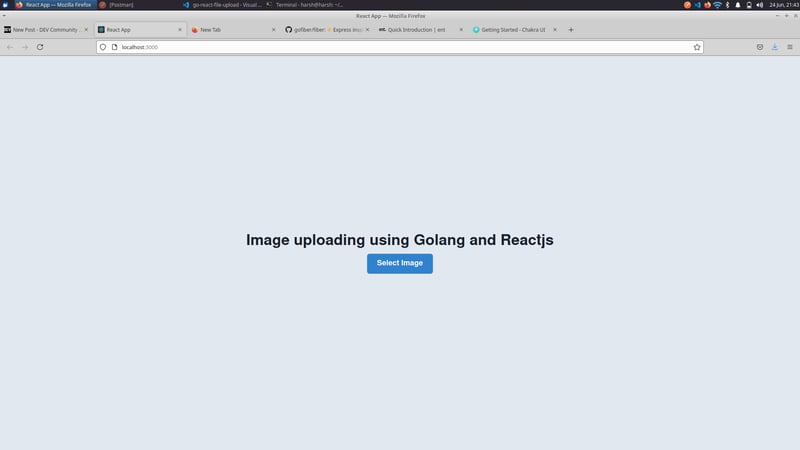
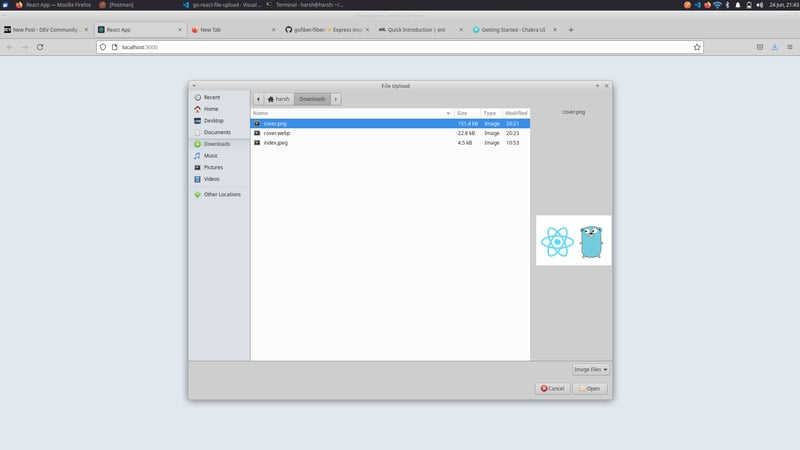
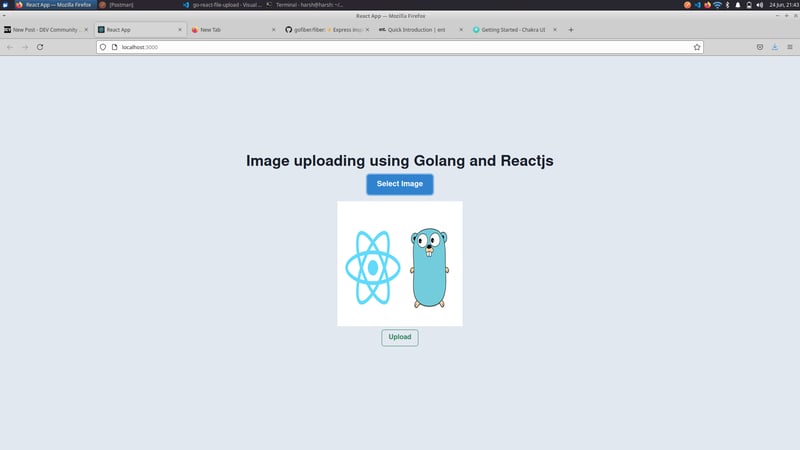
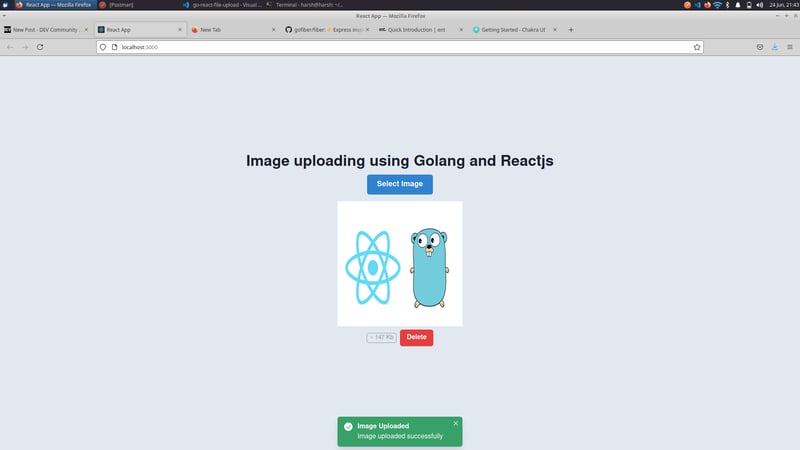
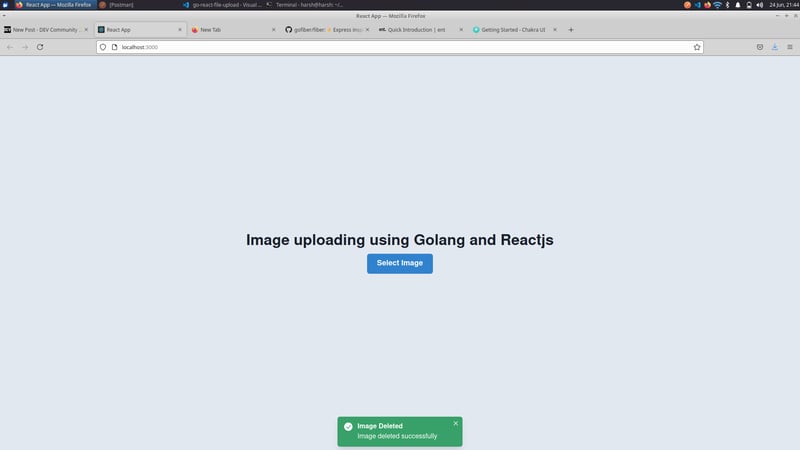






Latest comments (3)
hi @harshmangalam
how about passing variable image to next handler ?? like in node express ??
i hope you can show me.
thanks.
hi harsh,
may i know the dependencies used for reactjs?
i am using environment node js version v17.1.0 and yarn version yarn version v1.22.15
info Current version: 0.1.0 I found bugs
Dependencies are always in package.json file
github.com/harshmangalam/golang-re...